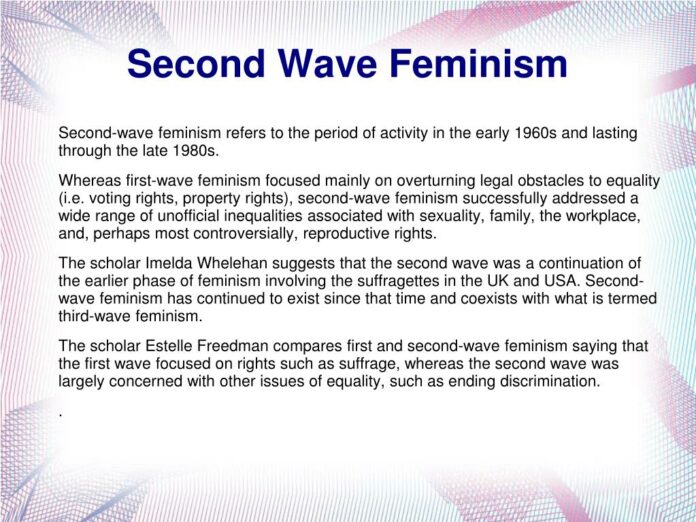Second-wave feminism, emerging in the 1960s and extending into the 1980s, marked a significant development in the feminist movement by addressing various sociopolitical and cultural issues affecting women’s lives. Yet, despite its notable achievements, this phase of feminism is not devoid of drawbacks. By critically analyzing the limitations of second-wave feminism, we can gain a nuanced understanding of its impact and legacy, recognizing not only the strides made toward achieving gender equality but also the challenges and exclusions that accompanied this movement.
Contextualizing Second-Wave Feminism
Second-wave feminism arose against the backdrop of immense societal upheaval. The post-World War II era catalyzed a transformation; women were increasingly seeking roles beyond the domestic sphere, ignited by the civil rights movement and anti-war sentiments. However, this wave primarily centered on the experiences of predominantly middle-class white women, focusing on issues such as reproductive rights, workplace equality, and sexual freedom without adequately addressing the differing realities faced by women of color, working-class women, and those with intersectional identities. This oversight underscores a primary flaw in the second-wave feminist ideology, one that continues to reverberate in contemporary feminist discourse.
Fragmentation of the Feminist Movement
One of the significant drawbacks of second-wave feminism was its internal fragmentation. Although the movement aimed to unify women under a common goal of gender equality, it often failed to encompass the various perspectives within the broader female experience. This phenomenon led to the emergence of a hierarchy within feminism, privileging the voices of white, middle-class women while marginalizing others. For instance, while the founding texts of second-wave feminism, such as Betty Friedan’s “The Feminine Mystique,” provided a critical examination of suburban housewives’ oppression, they neglected the roles and struggles of women in the labor force, women of color, and LGBTQ+ individuals.
Consequently, these oversights fostered divisions among feminists and created a sense of alienation among those whose challenges were inadequately represented. The lack of inclusivity soon paved the way for the emergence of third-wave feminism, which sought to address these disparities but also raised questions about the effectiveness of second-wave strategies and their overall impact on the fight for equality.
Elimination of the Male Voice
Another drawback deserving of scrutiny is the pervasive narrative that second-wave feminism often adopted an adversarial stance toward men. While confronting systemic patriarchy is essential, the essentialization of men as antagonistic figures contributed to an atmosphere that sometimes alienated potential allies. This binary framing negated the importance of male engagement in the feminist cause, culminating in a narrative that sometimes positioned women solely as victims of male oppression. This exclusionary rhetoric inadvertently reinforced the notion of a monolithic femininity and masculinity, complicating the discourse around gender roles and responsibilities.
Reductionist Approaches to Gender
Second-wave feminism also advanced reductionist approaches to gender, often conflating femininity exclusively with oppression. This sidelining of nuanced experiences and paths toward liberation is problematic. For many women, bringing a diverse range of experiences to the table is crucial; however, the focus on a singular narrative of victimhood obscures the diverse realities women inhabit. Intersectionality, a term coined by Kimberlé Crenshaw, remains a critical point of discussion, highlighting how race, class, and gender intersect to shape individual experiences. Yet, second-wave feminism frequently failed to integrate these complex dynamics into its advocacy, which perpetuated a homogenized view of womanhood that remains limiting to contemporary feminist praxis.
Neglect of Global Feminist Issues
Moreover, second-wave feminism has been criticized for its insular perspective, narrowly focusing on issues primarily pertinent to Western women. As global feminism emerged, it became evident that the struggles faced by women in different cultural and sociopolitical contexts were often overlooked. The emphasis on reproductive rights, workplace equality, and sexual liberation did not necessarily resonate with women in non-Western societies, where challenges such as access to education, systemic violence, and legal inequalities were paramount. This insensitivity to the glocalized nature of feminist issues ultimately restricted the movement’s potential to establish a truly inclusive and comprehensive approach to women’s rights.
Contemporary Reflections on Second-Wave Feminism
In reflecting on the legacy of second-wave feminism, it is essential to acknowledge its contributions while also recognizing its limitations. The movement played a pivotal role in enshrining women’s rights into legislative frameworks—gains that should be celebrated. However, the drawbacks outlined herein challenge us to reckon with the complexities of modern feminism. Acknowledging the imperfections within second-wave feminism is crucial in paving the way for future movements that genuinely represent the diverse spectrum of women’s experiences.
Bridging the Divide: Feminism’s Future
As the world navigates the intricate challenges of gender inequality in the twenty-first century, it is imperative to foster a feminist discourse that is inclusive and intersectional. Building upon the lessons of second-wave feminism while expanding the dialogue to incorporate the voices of marginalized women is not just beneficial; it is essential. Future feminist movements must prioritize collaboration among diverse identities within the feminist umbrella, recognizing that the fight for equality transcends singular experiences of oppression. Only through an honest reckoning with the past can advocates of gender equality cultivate a movement that embraces the complexities of womanhood.
Conclusion: A Call to Action
In conclusion, while second-wave feminism undeniably advanced women’s rights, it is imperative to interrogate its drawbacks critically. The movement’s fragmentation, reductionist approaches, exclusionary narratives, and insular perspectives continue to influence contemporary feminist discourse. As modern feminists, there lies a compelling responsibility to ensure that the next wave embodies the diversity, vibrancy, and complexity inherent in womanhood. Adopting an inclusive framework is not merely an ideological aspiration; it is an urgent necessity that informs the ongoing struggle for justice and equity. As we engage with the tenets of second-wave feminism, we must challenge ourselves to evolve and create a movement that earns the voices it seeks to uplift.





























